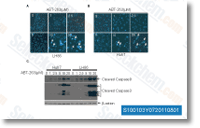The apoptosis assay was carried out as previously described. Just, TRAIL was substituted for STS inside a 3 hour incubation at a concentration of 3. 4 ug ml. Microarray hybridization and examination The therapy RNA and reference RNA have been concen trated to 5 ug RNA in twelve ul RNase no cost water for cDNA synthesis. The FairPlay III kit was applied for getting ready labeled cDNA with some modifications. 500 ng ul random hexamer resolution was made use of from the reaction, and the moment the cDNA was synthesized, the treatments and reference were purified using ethanol precipitation by which the samples have been positioned at 20 C for 1 hour. Subsequent, the NHS Ester containing dye coupling response was per formed according to the protocol. The reference and therapy cDNA have been subsequently indirectly labeled with Cy3 and Cy5 fluorophores, respec tively.
The samples were then purified to get rid of uncou pled dye, along with the labeled cDNA was eluted in 50 ul of 10 mM Tris base, pH eight. five. The cDNA was analyzed by means of a spectrophotometer to find out dye incorporation and cDNA yield. The reference sample was mixed with just about every with the treatment options selleck chemical PP242 in order that every treatment method had one ug of cDNA and one ug of reference cDNA. The samples have been concentrated during the velocity vacuum on medium heat to 44 ul, and after that eleven ul of 10? blocking agent. 1 ul poly d 40 60. one ul yeast tRNA was added to the samples. The mixtures have been heated to 98 C for 2 minutes, cooled briefly, and also the two? hybrid ization buffer was extra. leading to a last volume of 110 ul for every sample. The samples had been loaded onto the ExonHit Therapeutics microarrays for hybridization at 65 C.
Soon after overnight selleck inhibitor hybridization, the arrays have been washed and scanned employing a 4000A scanner as well as GENEPIX three. 0 software package. Data have been collated applying the Stanford Microarray Information base in which spots showing clear abnormalities have been excluded in the evaluation and an uncentered met ric was employed through the clustering. Treatment method conditions across all time points had been grouped right into a single condi tion, and just about every affliction was then compared on the other treatment method situations to reveal alterations in eukaryotic gene expression which might be crucial for apoptosis inhibi tion in the presence of STS in Shigella infected cells. This grouping allowed us to identify modifications in gene expres sion in only those genes exhibiting the most constant and sizeable improvements within every therapy group.  The sig nificance analysis of microarray plan model two. 20 and the students t check with a p value cutoff of much less than 0. 01 had been used to produce the list of major genes. The false discovery price with the 4 pairwise comparisons did not exceed three. 1%. The genes in Addi tional file 2, Table S2 have been categorized by function and or pathway employing the gene descriptions provided by NCBIs Entrez Gene.
The sig nificance analysis of microarray plan model two. 20 and the students t check with a p value cutoff of much less than 0. 01 had been used to produce the list of major genes. The false discovery price with the 4 pairwise comparisons did not exceed three. 1%. The genes in Addi tional file 2, Table S2 have been categorized by function and or pathway employing the gene descriptions provided by NCBIs Entrez Gene.
No related posts.
